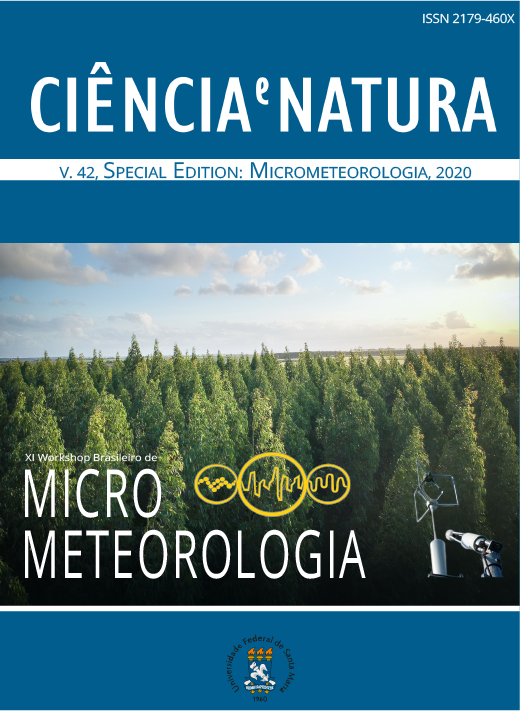Estimativa do campo de vento em alta resolução pelo Modelo Wind Ninja para estimativa em Energia Eólica
DOI:
https://doi.org/10.5902/2179460X53215Palavras-chave:
WRF, Wind Ninja, Métodos Numéricos, Previsão de VentoResumo
Neste trabalho foi proposto prever campos de ventos em alta resolução com o objetivo de simular as variáveis de velocidade e direção do vento no complexo eólico de Cerro Chato localizado na cidade de Santana do Livramento/RS. Para isso, utilizou-se técnicas de previsão numérica do tempo, no qual se fez uso do modelo \textit{Weather Research and Forecasting} (WRF) e um modelo diagnóstico de conservação de massa e momentum, em microescala, conhecido como Windninja. Neste estudo comparou-se os dados simulados com os dados de observação coletados pelas torres do parque eólico em questão, por meio de procedimentos estatísticos. Os resultados apresentados pelo software de simulação Windninja foram eficientes, porém, pouco eficazes.
Downloads
Referências
FORTHOFER, J.; SHANNON, K.; BUTLER, B. Simulating diurnally driven slope winds with windninja. USDA Forest Service, Rocky Mountain Research Station, Missoula, MT, 2009.
HONG, S.-Y.; NOH, Y.; DUDHIA, J. A new vertical diffusion package with an explicit treatment of entrainment processes. Monthly weather review, v. 134, n. 9, p. 2318–2341, 2006.
KAIN, J. S. The kain–fritsch convective parameterization: an update. Journal of applied meteorology, v. 43, n. 1, p. 170–181, 2004.
METED. Fundamentos de los modelos: Versión 2. Booklet, 2010.
METED. Fundamentos de pnt: Física del modelo. Booklet, 2014.
NATIONAL CENTER FOR ATMOSFERIC RESEARCH – Wrf-arw online tutorial. Estados Unidos – 2019.
NOAH - Implementation and verification of the unified noah land surface model in the wrf model. - 2014.
OLIVEIRA, A. M. de; SILVA, J. R. da; GOMES, R. G. Testes nas parametrizações de microfísica e de camada limite planetária na simulação de um sistema convectivo de mesoescala. Universidade Federal de Pelotas, 2010.
QUÉRÉ, C. L. et al. Global carbon budget 2016. 2016.
SAWYER, S.; FRIED, L.; SHUKLA, S.; QIAO, L. Global wind report 2017—annual market update. Global Wind Energy Council: Brussels, Belgium, 2017.
STENSURD. An overview of convection parametrization. Booklet, 2012.
WILKS, D. S. Statistical methods in the atmospheric sciences. Academic press, 2011.
Downloads
Publicado
Como Citar
Edição
Seção
Licença
Para acessar a DECLARAÇÃO DE ORIGINALIDADE E EXCLUSIVIDADE E CESSÃO DE DIREITOS AUTORAIS clique aqui.
Diretrizes Éticas para Publicação de Revistas
A revista Ciência e Natura está empenhada em garantir a ética na publicação e na qualidade dos artigos.
A conformidade com padrões de comportamento ético é, portanto, esperada de todas as partes envolvidas: Autores, Editores e Revisores.
Em particular,
Autores: Os Autores devem apresentar uma discussão objetiva sobre a importância do trabalho de pesquisa, bem como detalhes e referências suficientes para permitir que outros reproduzam as experiências. Declarações fraudulentas ou intencionalmente incorretas constituem comportamento antiético e são inaceitáveis. Artigos de Revisão também devem ser objetivos, abrangentes e relatos precisos do estado da arte. Os Autores devem assegurar que seu trabalho é uma obra totalmente original, e se o trabalho e / ou palavras de outros têm sido utilizadas, isso tem sido devidamente reconhecido. O plágio em todas as suas formas constitui um comportamento publicitário não ético e é inaceitável. Submeter o mesmo manuscrito a mais de um jornal simultaneamente constitui um comportamento publicitário não ético e é inaceitável. Os Autores não devem submeter artigos que descrevam essencialmente a mesma pesquisa a mais de uma revista. O Autor correspondente deve garantir que haja um consenso total de todos os Co-autores na aprovação da versão final do artigo e sua submissão para publicação.
Editores: Os Editores devem avaliar manuscritos exclusivamente com base no seu mérito acadêmico. Um Editor não deve usar informações não publicadas na própria pesquisa do Editor sem o consentimento expresso por escrito do Autor. Os Editores devem tomar medidas de resposta razoável quando tiverem sido apresentadas queixas éticas relativas a um manuscrito submetido ou publicado.
Revisores: Todos os manuscritos recebidos para revisão devem ser tratados como documentos confidenciais. As informações ou ideias privilegiadas obtidas através da análise por pares devem ser mantidas confidenciais e não utilizadas para vantagens pessoais. As revisões devem ser conduzidas objetivamente e as observações devem ser formuladas claramente com argumentos de apoio, de modo que os Autores possam usá-los para melhorar o artigo. Qualquer Revisor selecionado que se sinta desqualificado para rever a pesquisa relatada em um manuscrito ou sabe que sua rápida revisão será impossível deve notificar o Editor e desculpar-se do processo de revisão. Os Revisores não devem considerar manuscritos nos quais tenham conflitos de interesse resultantes de relacionamentos ou conexões competitivas, colaborativas ou outras conexões com qualquer dos autores, empresas ou instituições conectadas aos documentos.






